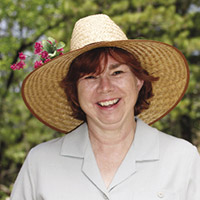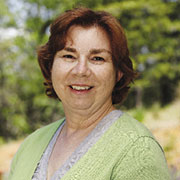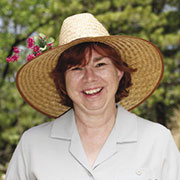Gardening Q&A
-
As a California Bountiful reader, you have the opportunity to get your seasonal gardening questions answered by gardening expert Pat Rubin. Here are a few questions from other readers.My roses, dahlias and zinnias all have powdery mildew. What do I do to keep this from happening next year?
It seems all sorts of plants get powdery mildew. The leaves look as though they have a coating of a powdery substance. The solution is to spray the plants with 2 1/2 tablespoons of horticulture oil (available at all nurseries) and 4 teaspoons baking soda in 1 gallon of water. Don't spray when temperatures are above 90 degrees. I used to get dry-air mildew on crape myrtles and was told to spray the leaves with water occasionally to wash it away. The plants never seemed to get it where the sprinklers hit, so that made sense.What is a cover crop?
A cover crop is one you plant while your garden would otherwise be fallow. They are planted to improve the soil by allowing water penetration, reducing weeds and preventing erosion. Often, cover crops are turned under at the end of the season to add organic matter to the soil. Cover crops include clover, alfalfa, peas, beans, marigolds, mustard and rye, among others.About Pat Rubin, California Bountiful's gardening expert

Pat RubinFor Pat Rubin, gardening is more than just dirt and plants. "It's about history, romance, adventure and people," she says. "And it should be fun."
California Bountiful's gardening columnist has lived and chronicled this fun, hands-in-the-dirt approach for years—and for additional publications including Fine Gardening, Pacific Horticulture, Christian Science Monitor, Family Circle and The Sacramento Bee. Pat has also volunteered as a Master Gardener, speaks to garden clubs and appears regularly on gardening radio shows.
Need gardening advice? Ask the expert!
Send your questions to gardening@californiabountiful.com
-
As a California Bountiful reader, you have the opportunity to get your seasonal gardening questions answered by gardening expert Pat Rubin. Here are a few questions from other readers.
Hi Pat,
I'm moving into a new home in Davis this fall and hoping to start a garden in mid-August. What herbs would you suggest for a shaded backyard? I'm thinking I'll put most in pots as I'd like to plant a winter garden of cole plants, root plants and lettuce greens. Any recommendations would be much appreciated.
Olivia
Hi Olivia,
I'm glad to hear you have some shade because the valley sun in August is tough. You will discover that summer is our harshest season. You should be able to plant cauliflower, broccoli and many other fall crops. I'd wait a bit on lettuce and greens, since there is a lot of hot weather ahead and greens bolt (produce flowers and go to seed) in hot weather much more quickly than when the weather is milder. Check your local nurseries to see what they have in stock. If you are new to gardening, starter plants rather than seed would be the best way to begin.
Since the garden is to be in pots, here are a few more tips:
- Select the biggest pots you can; the bigger the pot, the more protection for the roots. Pots also collect heat out in the sun.
- Choose a soil mix that has plenty of organic matter and that is a mixture of ingredients rather than a sterile mix.
- Add a layer of mulch to the top of the pots after planting to keep the soil protected.
- When watering pots, water gently until water runs out the bottom. Nutrients also run out, so you may need to use a time-release fertilizer. There are many types on the market, including organic ones.
Your local UC Cooperative Extension is a good source for letting gardeners know what to plant when, and you can find them online: http://ucanr.edu/County_Offices/.
Hope this helps. Let me know if you have further questions.
Pat
My basil is blooming, and I'm not getting new stalks. Does this mean it will die?
Basil is an annual, so its "job" is to grow, bloom, produce seed and die. However, as gardeners we have other plans for this wonderfully scented plant. We want leaves, leaves and more leaves. So, when you see the plant trying to bloom, cut the flowers away and the plant will continue to produce leaves. Keep harvesting them as well, so the plant continues to grow. It will keep trying to bloom, so be vigilant in pulling off the flowers. I make pesto when the plant is producing heavily, and cut stems for drying leaves when it is slowing down. (California Bountiful foodie Gwen Schoen shares her favorite pesto recipe!)
What makes my cucumbers bitter?
Usually, the culprit is too little water or erratic watering practices. Add plenty of organic matter to the soil and keep it mulched to conserve water and prevent the soil from getting hard. Water regularly, every day at first until young roots grow deeply into the ground. Also, harvest cucumbers when they are young and slim.The English lavender isn't blooming as well this year as past years. What happened?
Unfortunately, English lavender lasts only five to seven years in the garden. It just grows itself out. The plant eventually gets so woody it can make only spindly growth. There are some things you can do to manage the plant and to get a few more years out of it, but it won't last forever. Here's what I do: After the plant blooms, I cut it back severely—down to 6 or 8 inches. I cut back the woody growth. It seems harsh, but the plant bounces back and looks great for years with this sort of annual treatment. Spanish lavender is another story. It likes to sprawl and resents being cut back. Cut it back and it will likely never recover.About Pat Rubin, California Bountiful's gardening expert

Pat RubinFor Pat Rubin, gardening is more than just dirt and plants. "It's about history, romance, adventure and people," she says. "And it should be fun."
California Bountiful's gardening columnist has lived and chronicled this fun, hands-in-the-dirt approach for years—and for additional publications including Fine Gardening, Pacific Horticulture, Christian Science Monitor, Family Circle and The Sacramento Bee. Pat has also volunteered as a Master Gardener, speaks to garden clubs and appears regularly on gardening radio shows.
Need gardening advice? Ask the expert!
Send your questions to gardening@californiabountiful.com
-
As a California Bountiful reader, you have the opportunity to get your seasonal gardening questions answered by gardening expert Pat Rubin. Here are a few questions from other readers.
Hi Pat,
I have a 6-year-old dwarf tangerine tree. It produced more than 200 delicious tangerines this winter. However, the leaves are now turning yellow and many are dropping. This has not happened before. I did have a problem with a tunneling animal for the last two months. Is there a connection or is it just a lack of nutrients? I have never fertilized the tree.
Dennis
Hi Dennis,
Based on what you've said, I'd put the blame squarely on the tunneling critters. Since nothing else has changed as far as the care of the tree, that seems the most likely culprit. Gophers and moles are tough to control. The gophers eat plant roots while the moles are looking for grubs. However, the moles disturb plant roots along the way.
I would give the plant a light dose of fertilizer, and by light I mean half of what the box recommends, every few weeks to at least give it a boost while dealing with this problem. Also try patting the soil back down if it is the gopher hills you are seeing on top of the ground. If it's moles, you'll see the ridges on top of the ground left by the tunneling.
I would also go the UC Cooperative Extension website and see what they say about gophers and moles. Here are a few to look at:
cesonoma.ucdavis.edu
www.ipm.ucdavis.edu
ucipm.ucdavis.eduGood luck,
PatWhat is an easy thing for me to do to make sure my plants can survive on little water this summer?
The easiest, fastest and probably most effective measure to protect plants from summer heat—whether during a drought or a normal summer—is mulch. Add a 3- or 4-inch layer of chipped bark or leaves to all your flowerbeds, and I guarantee your plants will use less water. The reason is the mulch protects the soil, keeps it from baking and hardening in the sun, and keeps more moisture in the ground. Mulch also gives the garden a tidy appearance and prevents weeds from sprouting since they're denied sun.My cannas bloom beautifully, but the flowers don't last a long time, and after they're done the plants look a little messy. Can I cut them back or do I have to wait until the fall?
I used to think I had to leave the cannas stems alone until it was time to cut them back each fall, but learned that if I cut the stem that is done flowering to the ground, the roots will send up others and I'll get another flush of bloom. This works especially well if you have a big clump of cannas because you'll always have plenty of mature stems and ones about to bloom.I'm having a debate with a friend who says my lawn will need less water if I let it stay taller. I like to keep it cut short. Who is right?
Your friend is correct. Raising the blade on the lawnmower at or near its highest setting is best for water conservation. The blades of grass act as a living mulch to shade the soil and each other, so a lawn allowed to grow taller requires less water.About Pat Rubin, California Bountiful's gardening expert

Pat RubinFor Pat Rubin, gardening is more than just dirt and plants. "It's about history, romance, adventure and people," she says. "And it should be fun."
California Bountiful's gardening columnist has lived and chronicled this fun, hands-in-the-dirt approach for years—and for additional publications including Fine Gardening, Pacific Horticulture, Christian Science Monitor, Family Circle and The Sacramento Bee. Pat has also volunteered as a Master Gardener, speaks to garden clubs and appears regularly on gardening radio shows.
Need gardening advice? Ask the expert!
Send your questions to gardening@californiabountiful.com

